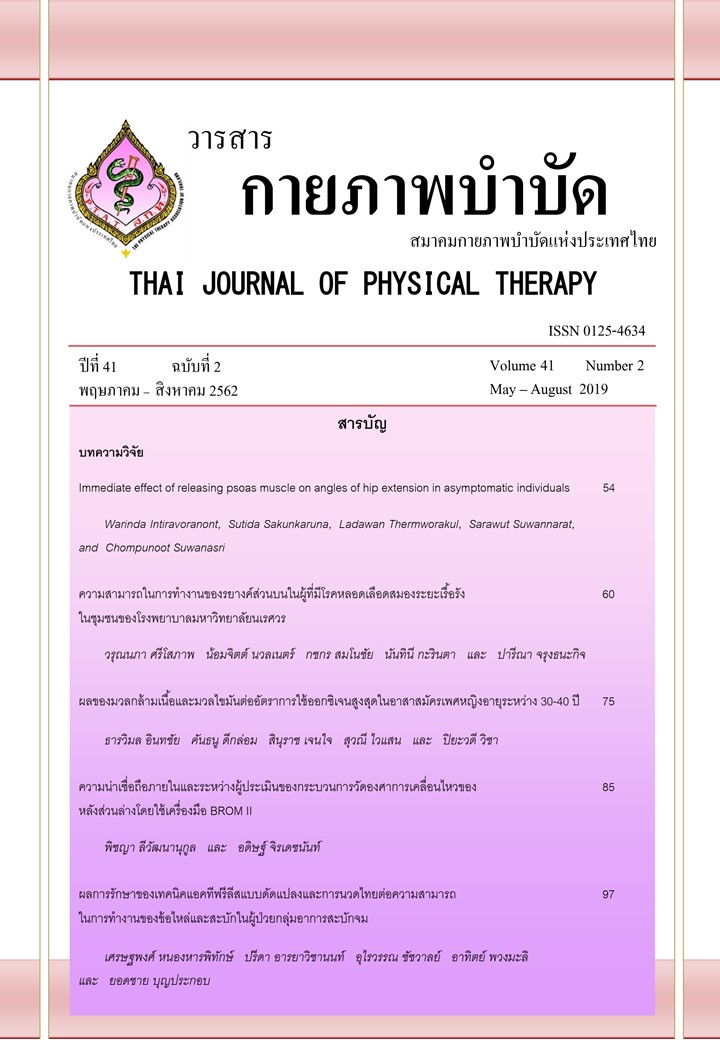Intra and inter-rater reliability of the lumbar range of motion procedure using back range of motion instrument (BROM II)
Main Article Content
Abstract
Background: Back range of motion instrument (BROM II) has been used to investigate the change of lumbar range of motions (LROM) in all directions. It has been noted that there would have some errors resulting in low both intra and inter tester reliability in some directions. For example, the measurement would not measure in a standardized protocol or directions and the consistent verbal instructions.
Objective: To investigate the intra and inter-rater reliability of the us of BROM II to measure LROM.
Method: Twenty healthy participants (10 women and 10 men) and 2 raters participated in this study. Prior to the measurement, all participants were asked to watch a 4-minute video clip. The video clip consisted of 3 parts; (1) finding reference points, (2) starting position and movements and (3) consistent verbal instruction. The participants were then marked the reference points and set the starting positions by the raters. The participants were asked to move lumbar spine in six directions twice and the first rater noted the LROM in the second trial. Then the other rater was called to note the LROM with the same manner. Data regarding the LROM were kept for further analysis using Intraclass correlation coefficient (ICC(3,1) and ICC(2,1)).
Results: The results of this study showed that the ICC(3,1) and ICC(2,1) were high ranging from 0.81 to 0.97 and 0.77 to 0.88, respectively.
Conclusion: The LROM procedure obtained by the BROM II was found to be reliable and suitable for research. The result from this study may provide useful information for design the protocol of the LROM measurement using BROM II.
Article Details
References
2. Merritt JL, McLean TJ, Erickson RP, Offord KP. Measurement of trunk flexibility in normal subjects: reproducibility of three clinical methods. Mayo Clin Proc. 1986; 61(3): 192-7.
3. Reese NB, Bandy WD. Joint range of motion and muscle length testing. St. Louis, Missouri: Saunders/Elsevier, 2002.
4. Teixeira F, Carvalho G. Reliability and validity of thoracic kyphosis measurements using flexicurve method. Rev Bras Fisioter. 2007; 11(3): 173-7.
5. Youdas JW, Suman VJ, Garrett TR. Reliability of measurements of lumbar spine sagittal mobility obtained with the flexible curve. J Orthop Sports Phys Ther. 1995; 21(1): 13-20.
6. Mirbagheri SS, Rahmani-Rasa A, Farmani F, Amini P, Nikoo MR. Evaluating kyphosis and lordosis in students by using a flexible ruler and their relationship with severity and frequency of thoracic and lumbar pain. Asian Spine J. 2015; 9(3): 416-22.
7. Nitschke JE, Nattrass CL, Disler PB, Chou MJ, Ooi KT. Reliability of the American Medical Association guides' model for measuring spinal range of motion: Its implication for whole-person impairment rating. Spine. 1999; 24(3): 262-8.
8. Kachingwe AF, Phillips BJ. Inter- and intrarater reliability of a back range of motion instrument. Arch Phys Med Rehabil. 2005; 86(12): 2347-53.
9. Ng JK, Kippers V, Richardson CA, Parnianpour M. Range of motion and lordosis of the lumbar spine: reliability of measurement and normative values. Spine. 2001; 26(1): 53-60.
10. Breum J, Wiberg J, Bolton JE. Reliability and concurrent validity of the BROM II for measuring lumbar mobility. J Manipulative Physiol Ther. 1995; 18(8): 497-502.
11. Haff, GG and Dumke, C. Laboratory manual for exercise physiology. Champaign, IL: Human Kinetics, 2012.
12. Williams R, Binkley J, Bloch R, Goldsmith CH, Minuk T. Reliability of the modified-modified Schober and double inclinometer methods for measuring lumbar flexion and extension. Phys Ther. 1993; 73(1): 33-44.
13. Yousefi M, Ilbeigi S, Mehrshad N, Afzalpour ME, Naghibi SE. Comparing the validity of non-invasive methods in measuring thoracic kyphosis and lumbar lordosis. Zahedan J Res Med Sci. 2012; 14(4): 37-42.
14. Yanagawa TL, Maitland ME, Burgess K, Young L, Hanley D. Assessment of thoracic kyphosis using the flexicurve for individuals with osteoporosis. Hong Kong Physiother J. 2000; 18(2): 53-7.
15. Brosseau L, Balmer S, Tousignant M, O'Sullivan JP, Goudreault C, Goudreault M, et al. Intra- and intertester reliability and criterion validity of the parallelogram and universal goniometers for measuring maximum active knee flexion and extension of patients with knee restrictions. Arch Phys Med Rehabil. 2001; 82(3): 396-402.
16. Saur PM, Ensink FB, Frese K, Seeger D, Hildebrandt J. Lumbar range of motion: reliability and validity of the inclinometer technique in the clinical measurement of trunk flexibility. Spine. 1996; 21(11): 1332-8.
17. Stovall BA, Kumar S. Anatomical landmark asymmetry assessment in the lumbar spine and pelvis: a review of reliability. PM&R. 2010; 2(1): 48-56.
18. Performance Attainment Associates. BROM 11: Back Range of Motion [brochure 8201 and video]. Roseville, Minn: Performance Attainment Associates; 1992.
19. Madson TJ, Youdas JW, Suman VJ. Reproducibility of lumbar spine range of motion measurements using the back range of motion device. J Orthop Sports Phys Ther. 1999; 29(8): 470-7.
20. Norkin CC, White DJ. Measurement of joint motion: a guide to goniometry. Philadelphia: F.A. Davis Company, 2016.
21. Tousignant M, Morissette J, Murphy M. Criterion validity study of lumbar goniometers BROM II and EDI-320 for range of motion of lumbar flexion of low back pain patients. J Back Musculoskelet Rehabil. 2002; 16(4): 159-67.
22. Bujang MA, Baharum N. A simplified guide to determination of sample size requirements for estimating the value of intraclass correlation coefficient: a review. Arch Orofac Sci. 2017;12(1):1-11.
23. Hoppenfeld S. Physical examination of the spine and extremities. New York: Appleton-Century-Crofts. 1976.
24. McIlroy WE, Maki BE. Preferred placement of the feet during quiet stance: development of a standardized foot placement forbalance testing. Clin Biomech. 1997; 12(1): 66-70.
25. Portney LG, Watkins MP. Foundations of clinical research: applications to practice. 2nd ed. Upper Saddle River: Prentice Hall Health, 2000.
26. Atya AM. The validity of spinal mobility for prediction of functional disability in male patients with low back pain. J Adv Res. 2013; 4(1): 43-9.
27. Mayer TG, Kondraske G, Beals SB, Gatchel RJ. Spinal range of motion. Accuracy and sources of error with inclinometric measurement. Spine. 1997; 22(17): 1976-84.

